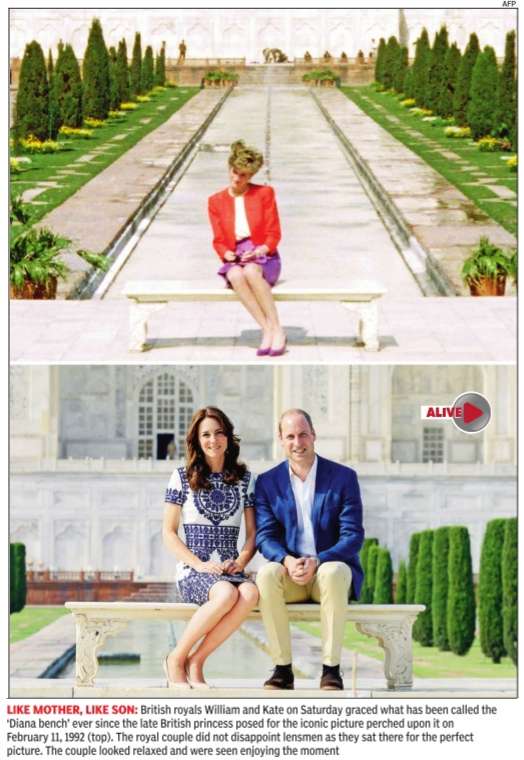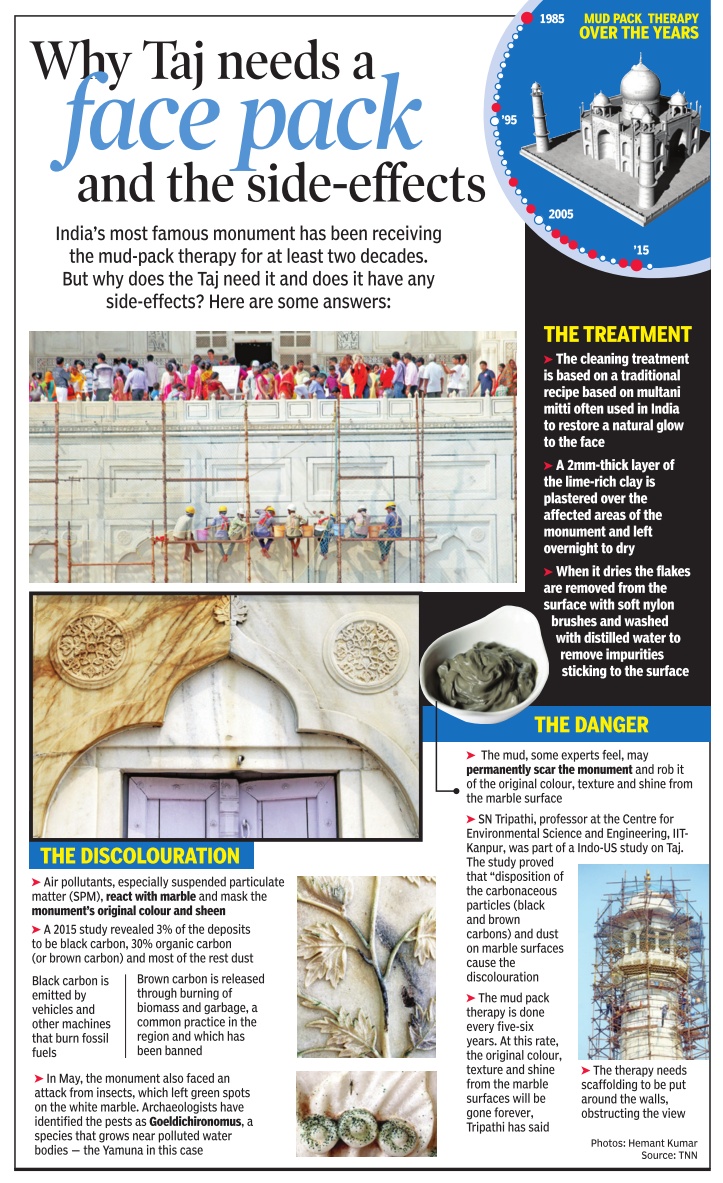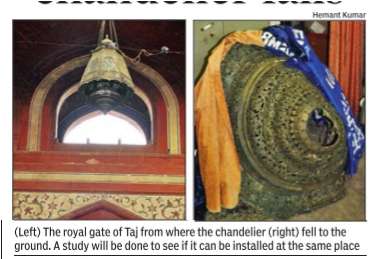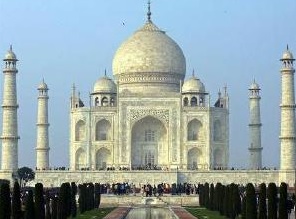Taj Mahal, Agra
This is a collection of articles archived for the excellence of their content. |
Contents |
A teardrop on the cheek of time
By Dr Syed Amir, Dawn, 2006

The celebrated Indian poet Rabindranath Tagore allegorically referred to the Taj Mahal in one of his verses as ‘one teardrop, glistening spotlessly bright on the cheek of time.’ Classified as one of the Seven Wonders of the World, the Taj is a testament to the eternal and enduring love of a man for his wife. It is visited by more than three millions tourists annually, up to 300,000 of them coming from outside India. In 1983, Unesco designated it a world heritage site.
More than three and half centuries have elapsed since the monument was built by Emperor Shah Jahan; however time has not been kind to this Islamic architectural masterpiece. Especially the decades since independence have witnessed a noticeable deterioration in its sparkling white appearance. In addition to the physical stress imposed by millions of visitors trudging on its delicate floors and through its spacious pavilions, atmospheric pollution and corrosive gases spewed by the iron foundries of Agra have inflicted major harm. Persistent exposure to pollutants in the air has dulled the brilliant shine of the porcelain-like marble, imparting a yellowish tinge to some sections of the facade.
The government has been concerned about preserving the beauty and mystique of the Taj that has become a symbol of national pride and a source of much revenue. However, combating the menace of air pollution eating into the marble surface poses a challenge far greater than maintaining the structural soundness of the building. The Indian Supreme Court, more than 10 years ago, had decreed the closure of factories and industrial units in the proximity of the Taj in a desperate attempt to reduce the level of pollution and retard discoloration of the marble surfaces. The decree had only marginal success. After much experimentation, Indian scientists have now come up with an ingenious and inexpensive solution. Application of Fuller’s earth (locally known as Multani Mitti) has long been recommended by Unani and Ayurvedic physicians for facial and skin rejuvenation. Scientists have discovered that briefly applying a thin coat of this to the Taj’s exterior, and then washing it off, can effectively restore much of its original glitter. The natural substance has the ability to extract and absorb the impurities and pollutants that have become embedded in the marble over a period of time.
The Taj Mahal’s current problems are not entirely recent in origin. In a recently published book entitled Taj Mahal, authors Diana and Michael Preston narrate in exquisite detail the planning, construction and completion of the magnificent monuments and its subsequent deterioration. With the decline of Mughal power and the disintegration of the central authority in the 18th- and 19th-century India, the Taj suffered many acts of vandalism at the hands of unruly bands of Jats and Marathas. Its precious and semi-precious floral inlays were chiseled away; lavish carpets, expensive wall hangings and an ornate door made of silver were removed and carted away.
British suzerainty brought no relief. Once Agra was captured by General Lake in 1803, the Taj Mahal became a playground for soldiers and employees of the East India Company. They would use its marble floors and terraces for late night dancing parties, while the mosque and tasbih khana on the two sides of the tomb were rented out to newlyweds to be used as weekend cottages.
Lord William Bentinck who served as the Governor General, first of Bengal and then of India from 1828-1835, had a reputation for stinginess and little appreciation of India’s cultural heritage. He is reported to have contemplated demolishing the Taj and auctioning off the rubble to raise money. The plan was, however, abandoned as it was estimated that the cost of demolition would exceed the amount of cash that could be raised by sale of the marble slabs. Although the story is repeated in several chronicles, its authenticity has been disputed by Bentinck’s biographer, John Rosselli and it might be only apocryphal. Regardless, it does reflect how little appreciation of the monument existed at the time.
Scientists have discovered that briefly applying a thin coat of this [Multani mitti] to the Taj’s exterior, and then washing it off, can effectively restore much of its original glitter.
The Taj remained in a state of neglect and disrepair for many years. Its once lush gardens, attractive water fountains and luxuriant flower beds were all withering away. Its fortunes were reversed with the appointment at the turn of the century of Lord Curzon as the viceroy of India (1898-1905).
An aristocrat educated at Oxford and appointed to one of the most powerful positions in the world at the young age 39, Curzon was reputed to be a supercilious person with an exaggerated sense of superiority. Fortunately, he also had a deep interest in the preservation and restoration of historic buildings of the Mughal era, especially the Taj Mahal.
Soon after his arrival Lord Curzon initiated a major restoration project of the Taj which he cherished. The work continued even after he left India and was completed in 1908. He ordered the construction of a brass hanging lamp; a replica of an antique lantern which he had originally seen and much admired in a mosque in Cairo, Egypt. He gifted it to the Taj where it still hangs from the ceiling of the interior chamber above the cenotaph.
Lord Curzon was extremely proud of the contribution he had made to the restoration of the Taj. In his speech delivered from the plinth of Taj Mahal — one of the last ones he gave as viceroy and cited by Diana and Michael Preston in their book — he proudly announced: ‘If I’d never done anything else in India, I have written my name here and the letters are a living joy.’
It may not be widely known that this mausoleum at Agra is not the first resting place of the young queen Arjumand Banu Begum, popularly known as Mumtaz Mahal. Although Mumtaz Mahal was not Shah Jahan’s only wife, the relationship between the two had been exceptional. They had been intensely devoted to each other and the emperor never travelled without her by his side.
The Mughals had been battling the kingdoms of Deccan for several generations in an attempt to subdue them. On one such occasion in 1629, Shah Jahan left the capital for Burhanpur on the Tapti River in present-day Madhya Pradesh at the head of a mighty Mughal army to suppress a local insurgency. The city at the time served as the capital and military headquarter of the Mughal Empire in the South.
In the summer of 1631, Mumtaz Mahal, pregnant with her 14th child, went into labour at the royal palace at Burhanpur. She gave birth to a stillborn baby and died of resultant complications, while the distraught Princess Jahan Ara, her daughter, and Shah Jahan were at her side.
It has been recorded by chroniclers that the emperor went into a period of deep mourning following the death of his beloved wife; his beard reportedly turning grey in a matter of days. He never took serious interest in the conduct of the state business thereafter.
Mumtaz Mahal’s body was temporarily interred in a tomb at Burhanpur for about six months and later moved to Agra in a golden casket arriving at the capital in regal splendour. Today, it reposes in the monument built in her memory, so ethereal and majestic that it has had no rival. The Taj Mahal provided succor and comfort to Shah Jahan during the final nine years of his life which he spent as a prisoner at Agra Fort from where he was permitted to gaze at the Taj, but never to visit it.
Maintenance
Mud therapy
NDTV, April 5, 2017
A kind of mud therapy is being used on Taj Mahal as the white marble structure is changing colour, the government told the Rajya Sabha today after members voiced concern over the maintenance of the world famous monument.
Culture Minister Mahesh Sharma said efforts are also being made to reduce the impact of insects on the 17th century structure.
During the Question Hour, members voiced concern over the maintenance of Taj Mahal, while referring to change in the colour of the marble structure and the damage caused by insects.
Mr Sharma said a kind of mud therapy, involving application of a paste of 'multani mitti', was being undertaken to preserve the colour of the monument.
It has been applied on three-fourths of the structure and is "showing results", he added.
He added that the National Environmental Engineering Research Institute (NEERI) has also submitted a report about the upkeep of the Taj.
To another question, Mr Sharma said the irrigation department had proposed creating a barrage to raise the water level of the Yamuna which has been approved by the Archaeological Survey of India.
Now it is for the state government of Uttar Pradesh to take a further action, the minister said. Mr Sharma also said that his ministry was planning a tourism circuit in Western Uttar Pradesh which would include the 'Dalit Prerna Sthal', F1 circuit, night safari, Kasna temple etc.
He said a proposal related to construction of national highways and overhead bridges etc near the protected monuments was under the consideration of the Law ministry.
DMK member Tiruchi Siva wanted to know whether the government had rejected the findings of a previous committee on 'Ram Setu' as it has set up a new panel.
Mr Sharma responded by saying that the government had not rejected the earlier findings.
He added that if there are any suggestions, there is a procedure and a new committee of experts may in the right perspective carry out a review.
Mud therapy harmful?

Aditya Dev Experts have raised concerns over the frequent use of mud pack therapy on the Taj Mahal to fight perils posed by pollution and insects. The therapy is currently being applied for the third time in the last 14 months on the monument's north wall. It is worried that frequent therapy may rob the Taj of its original colour and texture.
Officials of the Archaeological survey of India (ASI), which maintains the Taj, said frequent therapy mars the monument's aesthetic value.“At the rate it is being conducted, scaffolding will cover the monument most of the time,“ a senior ASI official said.
Mud pack therapy was done for the first time in April last year when the parliamentary standing committee on environment inspected the Taj following an Indo-US study which claimed that black and brown carbons along with dust were yellowing the monument. It was carried out again in September 2015 after hordes of insects left green patches on the walls. “It is the state's responsibility to take measures to curb pollution“ a senior official said.
The therapy , however, is “the safest and most-used method to clean monuments across the world,“ said an official from ASI's science branch.
S N Tripathi, professor at the Centre for Environmental Science and Engineering at IIT-Kanpur, who was part of the Indo-US study , had earlier told TOI, “With regular cleaning, the original colour, texture and shine from the marble surfaces will be gone forever.“
Was it a temple
2017: No, says ASI
Taj is a tomb, not a temple, ASI tells court for first time, August 26, 2017: The Times of India
For the first time, the Archaeological Survey of India has stated in a court hearing that the Taj Mahal is a tomb and not a temple. According to officials, a 1920 notification to protect Taj Mahal has been made the basis for the affidavit filed by the body here.
The Union culture ministry in November 2015 had already clarified in the Lok Sabha that there was no evidence of any temple at the Taj.
In April 2015, the Agra district court had admitted a suit filed by six lawyers that the Taj Mahal was a Shiva temple (Tejo Mahalaya) and Hindu devotees should be allowed access inside the premises. The court had issued notices to the central government, Union ministry of culture, home secretary and ASI to file their replies.
The ASI submitted its reply. It once again challenged the jurisdiction of the local court to hear and decide the case. The court, while giving time to the plaintiffs in the case to file their reply , fixed September 11 as the next date of hearing.
The ASI also challenged the locus standi of the plaintiffs in the matter, arguing that while the Taj is an Islamic structure, the plaintiffs were from other religions, and no practices of these religions had ever taken place at the monument.
Admission
Fee for international tourists
The Times of India, Apr 2, 2016
Foreigners’ Taj fee hike: 5,000 times in 50 yrs
Aditya Dev
The entry fee to see the Taj Mahal has risen in real terms by 200 times for Indians and 5,000 times for foreigners since 1966, when the ASI had first imposed a levy to see the 17th century mausoleum. However, when inflation rates are taken into consideration, the ticket price don't seem quite as steep.
The 20 paisa entry fee of 1966 is equivalent to Rs 5.7 in 2016. By this yardstick, there has been a seven-fold increase in price. In terms of affordability for the average Indian, a glimpse of the white marble monument has become only marginally expensive as the per capita income has increased manifold unlike the jump in entry fees, which was hiked after a gap of 15 years. In 1967-68, India's per capita annual income was Rs 622 which increased 150 times to Rs 93,231 in 2015-16.
An analysis of the historical data on ticket prices shows that it has been revised 11 times over the past 50 years and that differential pricing for Indians and foreign nationals is a recent phenomenon. For the first 34 years, 1966 to 2000, since introducing the entry fee, the price was same for both Indian and foreign tourists. Then in January 2000, the ticket price for international tourists was increased from Rs 15 to Rs 505. The prices were further revised in October 2000, when the rates were hiked to Rs 20 for Indians from the existing Rs 15 and Rs 970 for foreigners. Bucking the trend, 2001 witnessed a downward revision of ticket prices as the fee for foreigners was dropped to Rs 750. However, when inflation rates are taken into consideration, the ticket prices don't seem quite as steep. The 20 paisa entry fee of 1966 is equivalent to Rs 5.70 in 2016
2015: Chandelier falls down
Source:
1. The Times of India, Aug 22, 2015
2. The Times of India, Aug 23 2015, Aditya Dev

Taj's British-era chandelier falls
ASI orders probe
A 60-kg British-era copper chandelier at the main entrance of 17th century Taj Mahal crashed down recently, prompting the Archaeological Survey of India (ASI) to initiate a probe into the matter. The six-feet high and four-feet wide chandelier, gifted by Lord Curzon and installed at the Royal Gate of Taj Mahal in 1905, fell down on August 19, 2015, sources said.
Conservation skills of ASI have come in doubt after a huge copper and bronze chandelier gifted by Lord Curzon in 1909 and hanging at the royal gate of the Taj Mahal fell on the ground, damaging it. Though tourists were milling around, no one was hurt. ASI officials now say they are looking to fix and reinstall it at the same place. According to an ASI official, the six-foot high and fourfoot wide chandelier was a gift from Curzon and installed at the royal gate. “It is believed that when Curzon visited Agra and Fatehpur Sikri in 1905, he ordered the installation of this chandelier. He also got a Dak Bangla built at Fatehpur Sikri Fort during that time,“ the official added.
ASI superintending archaeologist Bhuvan Vikrama said, “An inquiry is being done to know the cause of its fall. Anybody's involvement has already been ruled out and it seems the chandelier fell because of natural wear and tear. We will do a study to see if it can be rein stalled at the same place.“
“Curzon had great interest in ancient monuments and a lot of attention was given to preserve them during his time.It was during his time the Ancient Monuments Preservation Act was passed in 1904. A great attention should be given to preserve the relics,“ MK Pundhir, medieval archaeologist from the Centre of Advance Studies in History at Aligarh Muslim University , said.
’No dress restrictions’
The Archaeological Survey of India (ASI) and Central Industrial Security Force (CISF) announced on Saturday that visitors to Taj Mahal were free to sport any colour or symbol, following days of protests triggered by foreign models being denied entry over scarves with Hindu symbols.
The announcement followed threats by members of two right-wing groups, Hindu Jagran Manch (HJM) and Bharatiya Janata Yuva Morcha (BJYM), to storm into the monument on Saturday wearing attire with Hindu symbols.
ASI and CISF officials, who have been on the back foot ever since the controversy broke out, said that there was no ban on wearing religious clothing at Taj Mahal unless the symbols and clothing were being used for any kind of promotion or demonstration or in violation of customs and practices followed at the monument.
ASI superintending ar chaeologist Bhuvan Vikrama said, “...There is no restriction. Our preliminary probe has revealed that the models were neither stopped by ASI nor CISF .“
He added that Union cul ture minister Mahesh Sharma had also clarified that people were free to visit the Taj in clothes of any colour.
Hours after the ASI clarification, over 200 members of BJYM, Bajrang Dal and VHP assembled near Tajganj and entered the monument in saffron attire and scarves.Earlier, they blocked the road leading to the Taj Mahal's east gate for more than two hours demanding the suspension of ASI and CISF officials who they alleged got the models to remove the scarves
